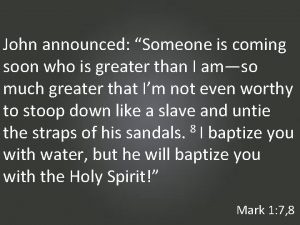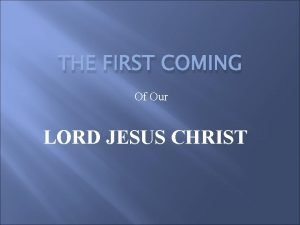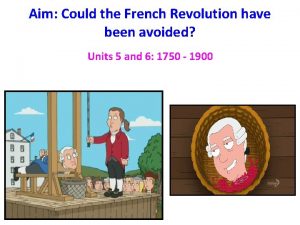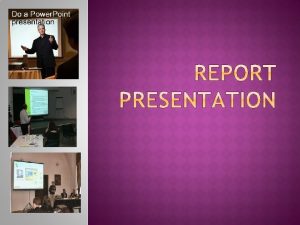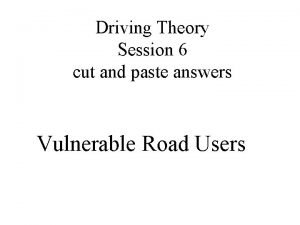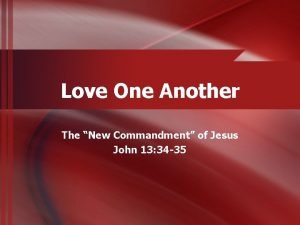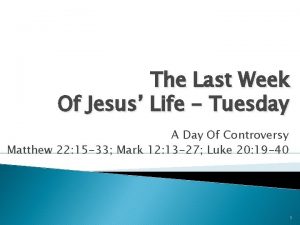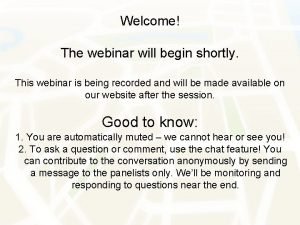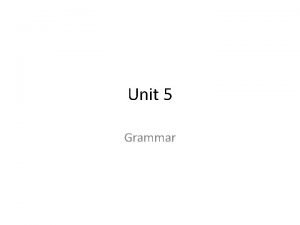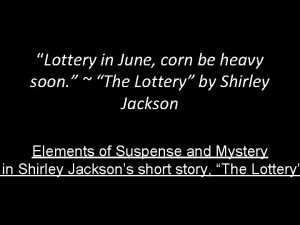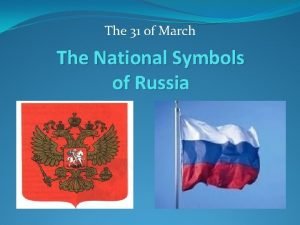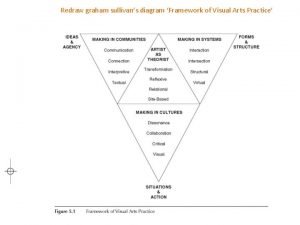Jesus is coming soon Are you ready Last


























































- Slides: 58

Jesus is coming. . . soon! Are you ready?

Last Day of Earth’s History For the righteous it is a day of deliverance For the wicked it is a day of destruction

Seven Trumpets Uncovering the meaning of the seven trumpets requires that we first review the history of the Christian church as told in the prophecies of the seven churches and the seven seals

Review of the Seals 1. White horse—early church; correlates with Ephesus church (A. D. 34 – 100) 2. Red horse—church under persecution; Smyrna (A. D. 100 – 313) 3. Black horse—church of the apostasy; Pergamos (A. D. 313 – 538) 4. Pale horse—church of the Dark Ages; Thyatira (A. D. 538 – 1300 s)

Traditions of Men Condemned “This people honoureth Me with their lips, but their heart is far from Me. Howbeit in vain do they worship Me, teaching for doctrines the commandments of men. ” Mark 7: 6, 7. “Beware lest any man spoil you through philosophy and vain deceit, after the tradition of men, after the rudiments of the world, and not after Christ. ” Colossians 2: 8.

Review of the Seals 5. Fifth seal—church of the Reformation; correlates with Sardis (1350 – 1798) 6. Sixth seal—church of the “time of the end”; Philadelphia (1798 – 1844) 7. Seventh seal—cleansing of the sanctuary; Laodicea (1844 – second coming)

John’s Vision of the Trumpets The vision of the trumpets REPEATS the time frame of the history of the seven churches and the seven seals, but here the prophecy tells of political history surrounding the Church; of wars, and pending judgments against the Church.

Trumpets in the Old Testament Blowing the shofar or ram’s horn “And the LORD spake unto Moses, saying, Speak unto the children of Israel, saying, In the seventh month, in the first day of the month, shall ye have a sabbath, a memorial of blowing of trumpets, an holy convocation. ” Lev. 23: 23, 24

Trumpets in the Old Testament “And thou shalt number seven sabbaths of years unto thee, seven times seven years; and the space of the seven sabbaths of years shall be unto thee forty and nine years. Then shalt thou cause the trumpet of the jubilee to sound on the tenth day of the seventh month, in the day of atonement shall ye make the trumpet sound throughout all your land. ” Leviticus 25: 8, 9.

Trumpets in the Old Testament “And if ye go to war in your land against the enemy that oppresseth you, then ye shall blow an alarm with the trumpets; and ye shall be remembered before the LORD your God, and ye shall be saved from your enemies. ” Num. 10: 8, 9.

Trumpets in the Old Testament “And ye shall compass the city, all ye men of war, and go round about the city once. Thus shalt thou do six days. And seven priests shall bear before the ark seven trumpets of rams' horns: and the seventh day ye shall compass the city seven times, and the priests shall blow with the trumpets. And it shall come to pass, that when they make a long blast with the ram's horn, and when ye hear the sound of the trumpet, all the people shall shout with a great shout; and the wall of the city shall fall down flat” Joshua 6: 3 -5

Trumpets in the Old Testament “And Zadok the priest took an horn of oil out of the tabernacle, and anointed Solomon. And they blew the trumpet; and all the people said, God save king Solomon. . . And when Joab heard the sound of the trumpet, he said, Wherefore is this noise of the city being in an uproar? . . . And Jonathan answered and said to Adonijah, Verily our lord king David hath made Solomon king. ” 1 Kings 39, 41, 43.

Trumpets in the Old Testament “And it shall come to pass in that day, that the great trumpet shall be blown, and they shall come which were ready to perish in the land of Assyria, and the outcasts in the land of Egypt, and shall worship the LORD in the holy mount at Jerusalem. ” Isaiah 27: 13.

Trumpets in the Old Testament “And it shall come to pass in that day, that the GREAT trumpet shall be blown, and they shall come which were ready to perish in the land of Assyria, and the outcasts in the land of Egypt, and shall worship the LORD in the holy mount at Jerusalem. ” Isaiah 27: 13.

Trumpets in the Old Testament “Blow ye the trumpet in Zion, and sound an alarm in My holy mountain: let all the inhabitants of the land tremble: for the day of the LORD cometh, for it is nigh at hand. . . Blow the trumpet in Zion, sanctify a fast, call a solemn assembly: gather the people, sanctify the congregation. . . ” Joel 2: 1, 15, 16.

Trumpets in the Old Testament “Blow ye the trumpet in Zion, and sound an alarm in My holy mountain: let all the inhabitants of the land tremble: for the day of the LORD cometh, for it is nigh at hand. . . Blow the trumpet in Zion, sanctify a fast, call a solemn assembly: gather the people, sanctify the congregation. . . ” Joel 2: 1, 15, 16.

Trumpets in the Old Testament • Announce the coming of the Day of Atonement • Declare the Day of Jubilee and freedom • Call to remember the Commandments of God • Declare war • Declare the day of final judgment of the world • Proclaim the new king’s coronation

Trumpets in the Old use of Testament Primary trumpets in the Judgment is coming! Old Testament was to warn of coming judgment against apostasy on the typical Day of Atonement

Trumpets in the Old use of Testament Primary trumpets in the Judgment is coming! Old Testament was to warn of coming judgment against apostasy on the typical Day of Atonement

Review of Revelation Prophecy Trumpets in the Bible — • Symbolize war • Announce judgment against enemies • Call God’s people to prepare spiritually for His final day of reckoning

Review of Revelation Prophecy Pergamos Church (A. D. 313 -538) • Compromise with paganism • Great “falling away” 2 Thess. 2: 1 -12 • Gnostic philosophy exalted • Traditions replace the Bible

Review of Revelation Prophecy Thyatira Church (538 -1789) • Papacy established • Doctrines were developed contrary to Bible truth • Persecution of God’s people by the church

Parallels to Seven Last Plagues • • Hail Fire Blood Sea and rivers effected Sea becomes blood Sea creatures die Three “parts” Darkness

Explanation of Symbols • First four trumpets concern the over throw of the western half of the old Roman Empire • “Third part” relates to the division of Roman Empire after Constantine the Great died

Overview of the Trumpets • First trumpet — Alaric and the Goths (395 to 410 A. D. ) • Second trumpet — Genseric and the Vandals (440 – 455 A. D. ) • Third trumpet — Attila and the Huns (434 – 452 A. D. ) • Fourth trumpet — Odoacer and fall of the Western Roman empire (476 A. D. )

Overview of the Trumpets • Darkness in the religious and political worlds (A. D. 538 - 1798) • Fifth trumpet — rise of Islam (first woe; A. D. 622 to 732) • Sixth trumpet — spread and collapse of Islam (second woe, 1299 to 1840)

Overview of the Trumpets • French Revolution and the close of prophetic time (1798 – 1844); • Reemergence of Islam (third woe; 1988 – ? ? ) • Seventh trumpet — second apartment ministry of Christ and final cleansing of the sanctuary; coronation of the KING of kings

Events Leading to Trumpets A. D. 325 – First Church Council at Nicaea to discuss how to handle the opinions of Arius regarding the divine nature of Christ A. D. 327 – Constantine’s sister begged him to recall Arius from banishment, and he did; after this Constantine sided with the Arians A. D. 359 – Every bishop in the empire were called to meet and make a final decision on the question of the divine nature of Christ

Events Leading to Trumpets A. D. 325 – First Church Council at Nicaea to discuss how to handle the opinions of Arius regarding the divine nature of Christ A. D. 327 – Constantine’s sister begged him to recall Arius from banishment, and he did; after this Constantine sided with the Arians A. D. 359 – Every bishop in the empire were called to meet and make a final decision on the question of the divine nature of Christ

Events Leading to Trumpets A. D. 325 – First Church Council at Nicaea to discuss how to handle the opinions of Arius regarding the divine nature of Christ A. D. 327 – Constantine’s sister begged him to recall Arius from banishment, and he did; after this Constantine sided with the Arians A. D. 359 – Every bishop in the empire were called to meet and make a final decision on the question of the divine nature of Christ

Events Leading to Trumpets A. D. 380 – Edict issued by Theodosius, coemperor with the two child emperors, sons of Valentinian — “It is our pleasure that the nations which are governed by our clemency and moderation, should steadfastly adhere to the religion which was taught by St. Peter to the Romans. . . We authorize the followers of this doctrine to assume the title of Catholic Christians; and as we judge that all others are extravagant madmen, we brand them with the infamous name of ‘heretics. ’”

Events Leading to Trumpets The historian Henry H. Milman stated: “Thus the religion of the whole Roman world was enacted by two feeble boys and a rude Spanish soldier. ” History of Christianity, Book III, chapter 9, par. 1

Events Leading to Trumpets Ulfilas (A. D. 311 – 383) was a Christian missionary who worked among the Goth nations and tribes on the northern frontiers of the old Roman Empire Ulfilas was strongly opposed to the allegorizing of the Bible that the Roman ecclesiastics were want to do to pacify the political leadership of Rome

Events Leading to Ulfilas was a Greek seventh-day Trumpets Sabbath-keeper, and taught the fourth commandment to the Goth nations. “It is a fact that formerly those who dwelt in the east were accustomed as a church to sanctify the Sabbath. . . It is, therefore, possible for the Goths to have thought, as pupils of the discipline of the Greeks, that they should sanctify the Sabbath. ” Sidonius Apollinaris, historian (A. D. 454 – 526)

Events Leading to Henry H. Milman stated: “There is no Trumpets trace of Arianism in the surviving remains of the Gothic translation of the New Testament. ” (History of Christianity, vol. III, p. 59). The Goths professed to adhere to the words of Scripture delivered to them by Ulfilas and called themselves Catholic, not Arian.

Events Leading to Trumpets As a result of the work of Ulfilas the Goths refused to believe as the church of Rome did, and as a consequence, they were branded heretics and Arians

Events Leading to Trumpets “The barbarians were easily provoked; they knew not how to forgive an injury, much less an insult; their resentments were bloody and implacable. The casual disputes that so frequently happened in their tumultuous parties of hunting or drinking were sufficient to inflame the minds of whole nations. . . To chastise the insolent, or to plunder the defenseless, were alike causes to war. ” (Edward Gibbons, Decline and Fall of the Roman Empire, chapter 9, par. 24).

First Trumpet “And the seven angels which had the seven trumpets prepared themselves to sound. The first angel sounded, and there followed hail and fire mingled with blood, and they were cast upon the earth: and the third part of the trees was burnt up, and all green grass was burnt up. ” Rev. 8: 6, 7.

First Trumpet “The pastures of Gaul, in which the flocks and herds grazed, were suddenly changed into a desert, distinguished from the solitude of nature only by smoking ruins. ” Edward Gibbons, Decline and Fall of the Roman Empire Like hail, the barbarians battered at the northern frontiers of the Roman Empire, first in one place then another.

First Trumpet A. D. 410 Alaric the Visigoth (western branch of the Goth tribes) conquered the city of Rome; he died shortly after at the age of 40, prompting the superstition that since he had invaded “God’s” city he was killed by God

Second Trumpet “And the second angel sounded, and as it were a great mountain burning with fire was cast into the sea: and the third part of the sea became blood; and the third part of the creatures which were in the sea, and had life, died; and the third part of the ships were destroyed. ” Rev. 8: 8, 9.

Second Trumpet Vandals, under cover of darkness, towed some ships loaded with combustibles into the harbor among the Roman fleet, setting fire to them. There were 1300 ships burned in one night.

Third Trumpet “And the third angel sounded, and there fell a great star from heaven, burning as it were a lamp, and it fell upon the third part of the rivers, and upon the fountains of waters; and the name of the star was Wormwood: and the third part of the waters became wormwood; and many men died of the waters, because they were made bitter. ” Rev. 8: 8, 9.

Third Trumpet Like a blazing meteor star, Attila’s devastations helped in the overthrow of the empire. He called himself “the Scourge of God. ”

Third Trumpet Attila the Hun began his harassment of the eastern sector of the Roman Empire before Genseric reached Rome. Both were invading parts of Rome during the same periods in history, one from the south, the other from the north. Genseric's final march on Rome occurred in A. D. 455; Attila died in A. D. 453. The prophecies must be evaluated more by how the symbols apply than by adhering strictly to dates.

Third Trumpet Genseric • “great mountain burning with fire cast into the sea” reflects the burning of the Roman fleet in one night when 1300 ships were lost • “third part of the ships destroyed” reflects the fact that this “third part” of the Roman empire lost its fleet

Third Trumpet Genseric • Captured all the major islands of the western sector of Rome • “third part of the sea became blood”; we define “sea” or “waters” by the Bible as meaning “peoples, multitudes, nations, tongues” (Rev. 17: 15)

Third Trumpet Attila • Blazed swiftly down from the frozen mountains to the north of Italy like a meteor • The major rivers of northern Italy have their headwaters in these same mountains; symbol of rivers fits here • This judgment had bitter consequences for this “third part” of the Roman empire

Fourth Trumpet “And the fourth angel sounded, and the third part of the sun was smitten, and the third part of the moon, and the third part of the stars; so as the third part of them was darkened, and the day shone not for a third part of it, and the night likewise. ” Rev. 8: 12.

Fourth Trumpet A. D. 476 the last western emperor dethroned by the Heruli under Odoacer

Prophecy of Daniel 2 “And as the toes of the feet were part of iron and part of clay, so shall the kingdom be partly strong, and partly broken. ” Daniel 2: 42.

Prophecy is Accurate Prophecy of Daniel’s ten horns was that three would be replaced by a “little horn” which came up among the ten. History proves this prophecy true. Papal Rome rose to power while destroying three tribes which opposed its purpose. Those three tribes “plucked up” were the Vandals, the Heruli, and the Ostrogoths.

Review of Revelation Prophecy

Summary of Trumpets “Mystery Babylon” assumes control of “truth” “Up to the time of the Babylonian exile, monotheism had waged a losing battle against idolatry, and ignorance of the Bible was commonplace. ” Abraham Bloch; The Biblical and Historical Background of the Jewish Holy Days, p. 15.

Summary of Trumpets “The Christians were pronounced atheists, because they were destitute of temples, altars, victims, priests, and all the pomp in which the vulgar [pagans] suppose the essence of religion to consist. ” “It is certain that to religious worship, both public and private, many rites were added, without necessity, and to the offense of sober and good men. ” Moshiem; Ecclesiastical History, Century II, part ii, chapter 4, par. 3 and 1.

Summary of Trumpets • Announce the coming of the Day of Atonement • Declare the Day of Jubilee and freedom • Call to remember the Commandments of God • Declare war • Declare the day of final judgment of the world • Proclaim the new king’s coronation


Partial Bibliography for trumpets study Edward Gibbons, Decline and Fall of the Roman Empire (1946) James Bryce, The Holy Roman Empire (1886) A. T. Jones, The Great Empires of Prophecy (1898) E. J. Waggoner, Fathers of the Catholic Church (1888) S. N. Haskell, The Story of the Seer of Patmos (1905) Philip Schaff, History of the Christian Church (1910) H. G. Wells, The Outline of History (1931) George Burnside, Revelation’s Wonders Unfolded (nd. ) Roy Allan Anderson, Unfolding the Revelation (1953) B. G. Wilkinson, Truth Triumphant (1944) Samuele Bacchiocchi, God’s Festivals, vol. 2 (1996) (editors) Source Book for Bible Students (1922) Roy C. Naden, The Lamb Among the Beasts (1996) G. K. Beale and D. A. Carson (eds. ), Commentary on the New Testament Use of the Old Testament (2007)
 Jesus is coming soon are you ready
Jesus is coming soon are you ready King jesus is coming
King jesus is coming Jesus is coming soon revelation
Jesus is coming soon revelation Baal ishtar
Baal ishtar Antigentest åre
Antigentest åre Stay ready to keep from getting ready
Stay ready to keep from getting ready John announced
John announced Ecwms
Ecwms You are my lord
You are my lord Jesus is the sweetest name i know
Jesus is the sweetest name i know Jesus in the morning jesus in the noon time
Jesus in the morning jesus in the noon time If you would not be forgotten as soon as you are dead
If you would not be forgotten as soon as you are dead It isn't ready yet question tag
It isn't ready yet question tag When is jesus coming to earth again
When is jesus coming to earth again Jesus second coming
Jesus second coming Coming of our lord jesus christ
Coming of our lord jesus christ You should hope that this game will be over soon
You should hope that this game will be over soon Did american revolution cause french revolution
Did american revolution cause french revolution Ladies and gentlemen presenting you
Ladies and gentlemen presenting you In daylight an approaching motorcyclist
In daylight an approaching motorcyclist Joining us today
Joining us today Thank you for attending open house
Thank you for attending open house Welcome thank you for coming
Welcome thank you for coming Back to school night thank you
Back to school night thank you Thank you for coming here
Thank you for coming here Do you get period pains when pregnant
Do you get period pains when pregnant You ready let's go
You ready let's go Ready for the lesson
Ready for the lesson Are you ready to be a parent
Are you ready to be a parent Are you ready for calculus answers with work
Are you ready for calculus answers with work Are you ready for the lesson
Are you ready for the lesson 3 2 1 are you ready
3 2 1 are you ready Where is judas in the last supper painting
Where is judas in the last supper painting Last commandment of jesus
Last commandment of jesus Tuesday last week
Tuesday last week No mundo murmura-se tanto harpa cristã
No mundo murmura-se tanto harpa cristã Jesus jesus how i trust him
Jesus jesus how i trust him Historischer jesus und kerygmatischer christus
Historischer jesus und kerygmatischer christus Meeting will begin shortly
Meeting will begin shortly Almost as soon as the gorilla television commercial
Almost as soon as the gorilla television commercial Please wait the webinar will begin soon
Please wait the webinar will begin soon Kristina soon
Kristina soon Presentation entreprise bts
Presentation entreprise bts Lottery in june corn be heavy soon
Lottery in june corn be heavy soon Dr jonathan botting
Dr jonathan botting The meeting will begin shortly
The meeting will begin shortly Lottery in june corn be heavy soon
Lottery in june corn be heavy soon Past simple past continuous farkı
Past simple past continuous farkı My king will soon come back again
My king will soon come back again Bye in lorean
Bye in lorean We will begin soon
We will begin soon Russia soon to become a key player
Russia soon to become a key player Yong soon min
Yong soon min As soon as well
As soon as well Education live will begin shortly
Education live will begin shortly Welcome we will start soon
Welcome we will start soon Reduced adverb clause
Reduced adverb clause The webinar will begin soon
The webinar will begin soon Dr ng swee soon
Dr ng swee soon






